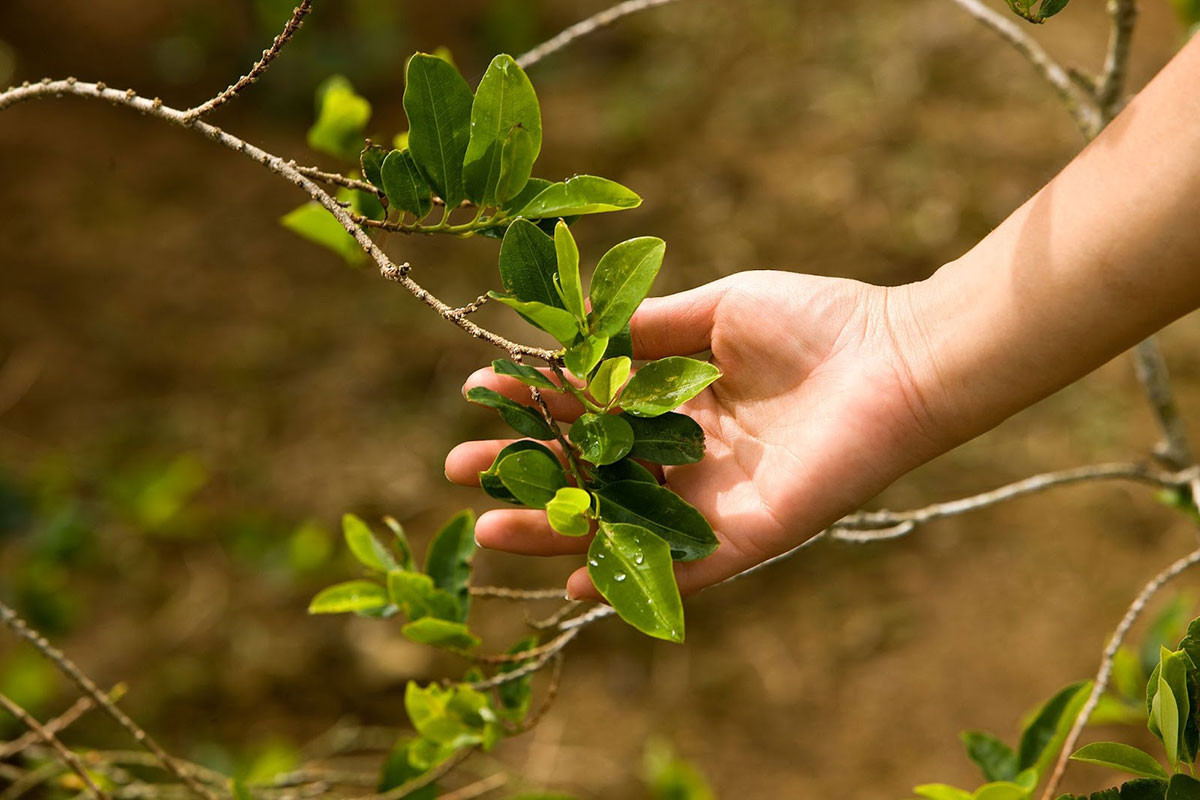All of us are here today thanks to our ancestors’ knowledge of medicinal plants and fungi. Without awareness of the pharmacopeia of the land, people would have had a much harder time surviving before the development of modern medicine.
When we think of psychoactive herbal medicines, ayahuasca, cannabis or magic mushrooms might come to mind. In this article, we’re going to focus on three plant medicines we think you should know about: coca, opium, and tobacco.
What Are Plant Medicines?
Modern medicine has an important place in emergency room settings, and for the prevention and treatment of disease. But the efficacy of medicinal herbs and fungi still rivals, if not surpasses, some modern treatments. Take Turkey Tail, Trametes versicolor, for example. This mushroom produces immune boosting compounds that rival anything the pharmaceutical industry has created. And, it’s easy enough to cultivate, and grows abundantly in the wild!
Herbs are as widely used across the globe as any other type of medicine. This is partly due to the lack of access to modern medical care in areas with extreme wealth stratification.
The World Health Organization (WHO) reports that 60% of the people across the world rely on herbs for their medical needs. In developing countries, around 80% of people depend primarily on herbal medicine. In the United States, herbal medicine is gaining in popularity as the lost knowledge of medicinal plants is rediscovered in our ancestral roots.
Plant Medicines and Psychedelics
Depending on your perspective and culture, plant medicines might be drugs, entheogens, or perhaps they are sacramental psychedelics. Everyone relates to plant medicines a little differently depending on their perspectives on life and their past experiences with psychedelics.
What might be universal is that some plant medicines have a special way of nurturing community ties and relationships. These plants generally become infused into a culture’s cosmology or world story. When asked where one’s ancestors came from, some of us might say a geographic location. However, for cultures that are deeply interconnected with their local web of life, the response would more likely be a story about how one’s ancestors came from Earth and Sky, or perhaps a local mountain or river. Quite frequently, plant medicines, or teachers as they are sometimes called, are integral to the creation story of many cultures.
From this perspective, a place or a plant is sacred because it is part of someone. It is a part of their body, being, and every breath and step they take. Infused with these additional layers of meaning, plant medicines are sacred in ways that Westerners rarely grasp from dualistic perspectives that see self and nature as separate. Imagine, if you can, that a plant is sacred to a culture and community because of their relationship with it, not because the plant is a sacred object.
From this participatory view, every plant and animal is kin and has a meaning and purpose. Not as objects that offer food or medicine, but rather, as living beings that teach, share, and show humans how to maintain balance with the ecosystem, themselves, and their communities.
Because relationships are subjective, it stands to reason that the relationships some people or cultures have built over millennia with plant medicines will be different than the relationships other cultures develop with the same plant. In an ideal situation, everyone respects the sanctity of another.
This is essential to keep in mind when talking about psychedelic medicines. Not only because we want to avoid industrializing sacred plant medicines and psychedelics, but because we may want to also reimagine our relationship with the world around us — including how we view and relate to the drug war that blocks access to psychedelic therapy and research.
Psychoactive Plant Medicines Across Cultures
For a thorough description of individual psychedelic plant medicines such as Iboga, San Pedro, Ayahuasca, and psilocybin-containing mushrooms, be sure to check out Psychable’s Beginner’s Guides section. But for a deeper dive into the roots of coca, opium, and tobacco, read on.
Coca – Erthroxylon coca
There are several species of the coca plant, and all of the leaves contain the alkaloid cocaine, which has been isolated and manufactured for a variety of applications. Cocaine and coca leaf are currently listed as a Schedule 2 substance in the United States.
Coca leaf has been used traditionally for over 4,000 years in the regions now called Colombia, Peru, and Bolivia. Indigenous peoples used the leaves of the tree as a stimulant to manage elevation sickness in the high-altitude Andes Mountains.
The Aymara people of the Andes and Altiplano areas refer to coca as “khoka” in the Quechua language, which is where our modern word for the plant originates. In Inca mythology, Kukamama was the coca goddess who brought joy and health. Nomadic tribes chewed on the leaves as they traveled for days without rest or food, often using the leaves as offerings to the mountains and spirits.
Coca was among the first domesticated crops of the region, and according to one recent paper, the cultivation process required the “reciprocal labor of women and men… this ancient practice of Andean reciprocity called ayni builds relationships of trust and mutual aid within and between rural communities over the long term.”
Before the Spanish colonized the area, coca was used to barter and as a medicine for treating pain, fever, and many ailments. Coca leaves were (and still are) used in sacred rituals to honor Pachamama, the Inca’s mother goddess, and to support women through birthing pains and birth rituals.Coca leaf was (and is) used in daily rituals and celebrations as well. Rather than framing this as “recreational” use (which it still arguably is by the nature of the effects) ritual and reverence for Pachamama are evident at every step. It is shared and consumed collectively, inspiring communication and building relationships.
Ultimately, chewing coca leaves serves to create “a sacred atmosphere that not only generates cohesion but seals the pact of collaboration.” This plant medicine now has a taboo reputation, but comes from a long line of important social functions in many Andean cultures.
The indigenous people of the Andes still use this sacred plant medicine, even though colonization brought the leaves to Europe, where cocaine was isolated, synthesized, and introduced into Western allopathic medicine as a stimulant and pain reliever. Meanwhile, the U.S. military drops herbicides in the Amazon rainforest to combat the illicit production of cocaine in the area. If the sacred view of coca was truly understood, then perhaps the United States would have a different relationship with coca, cocaine, and crack cocaine.
Opium – Lachryma papaveris
Opium is unique in that it has been integrated into herbal medicine for thousands of years and across many cultures. The opium poppy produces a latex-like substance that is most concentrated in the bulbs of the budding flowers, but opium is also present throughout the plant.
Both the opium poppy and dried opium have a long history of use in ritual, as an analgesic, and anesthetic. Opioid receptors are present in all mammals and are even activated by endogenous opioids that are present in breastmilk. Interestingly, there are also endogenous cannabinoids present in breastmilk, and both of their affiliated plant medicines, cannabis, and opium, are recognized by evolutionary biologists as being intimately linked to our survival over millennia.
Opium was revered as a plant medicine throughout the ancient world, and documented use dates back as far as 8,000 years. Documented use begins with ancient Sumerians who cultivated poppy in lower Mesopotamia where it was called Hul Gil, “the joy plant.”
After learning how to harvest the extract from the poppy, opium was spread throughout the ancient world, to Egypt and Thebes. There, trade flourished and expanded to ancient Greece and Crete, where a Minoan shrine was dedicated to the poppy goddess of fertility and health. Along the way, temples and rituals were devoted to the poppy as devotees honored the gift of relief and healing.
Hippocrates, the proverbial father of modern medicine, steered away from any sense of spiritual relationship with the poppy, focusing only on the plant medicine’s usefulness as a narcotic and for treating “diseases of women” throughout the Mediterranean.
The Black Plague and Inquisition put a damper on opium use and herbal medicines in Europe for several hundred years. Meanwhile, opium traveled further, along the Silk Road through India and to China, to the Buddhist monks who used the poppy in their diet, consuming it regularly for its medicinal and spiritual properties. The monks prepared poppy as a decoction, rather than smoking it. The flowers were often planted outside homes and were most commonly used in tea, milk, and porridge preparations. Opium was consumed communally and in ritualistic manners.
Roughly 2000 years ago during the Song dynasty, a traveling magistrate visited a Buddhist temple and was offered plant medicine in the form of tea. An elderly man, Lu You was grateful for the effect opium had, and took to making his own tea and writing poetry about the relief and joy it brought.
Lu You was not the only one that was moved to poetry; there are many accounts of joyful, recreational, and even culinary use of opium poppy recorded in the literature throughout several hundred years. Eventually, opium became absorbed into the expanding field of Chinese medicine, where global trade with Europe had resumed during the Renaissance and the public had moved on to concentrated alcohol-based opium tinctures.
Marketed in Switzerland as a proprietary drug in 1676, opium-based laudanum was often combined with other herbs and psychoactive plants. It would eventually transform under the microscope as chemists unraveled its molecular structures and intensified its effects and binding affinity to our opioid receptors.
Indeed, the analgesic effects of the opium plant are recognized across many cultures around the world. In Turkey, the opium poppy was known as “the father of sleep”. An old Turk saying goes, “there is no Turk who would not buy opium with his last penny.” George Young, an American surgeon, spoke to the addictive nature of laudanum in 1753: “everybody knows a large dose of laudanum will kill, so need not be cautioned on that head; but there are few who consider it a slow poison, though it certainly is.” The addictive potential of opium is higher than some other plant medicines, due to the way it acts on the brain and body.
Though far removed from the spiritual roots of the original plant medicine, even synthetic opiates are plant-based, plant-derived, or at the least plant-inspired at their roots. Perhaps, they might still invite a joyful story in our culture, for despite the potential risks, they allow people with chronic pain to function with joy and ease. Indeed, many people use opiates frequently, safely, and for therapeutic benefit. Fortunately, organizers are creating the social support systems needed to help people navigate dependencies, and sometimes that includes working with other plant medicine allies like iboga, which has a unique relationship with the mechanisms of opiate withdrawal.
Tobacco – Nicotiana rustica or Nicotiana tabacum
Tobacco is revered by indigenous cultures in North and South America. Many traditions say that it was given as a gift from the spirit realm and that the smoke helps carry the prayers up to the Creator. Some elders say that the roots of the tobacco plant go deep and the smoke goes high into the sky, connecting the worlds.
In the Shipibo lineage of ayahuasca shamanism, the tobacco brings positive energy into the ceremony space, cleanses the space, and deepens the healing work of the onanya (medicine person or shaman). According to the Yaminawa people, tobacco makes us dream. Blowing tobacco smoke is said to ward off negative energies; it can even help heal common ailments.
Tobacco can be smoked, chewed, taken as snuff, even drank as tea. Tobacco can be emetic, meaning that it can cause vomiting. Indeed, this is one of its recognized healing benefits as a plant. Tobacco can also be put on the soil or into the fire as prayer, gratitude, or offering.
It’s important to distinguish between recreational use and medicinal use, especially with a powerful plant like tobacco. According to the CA Rural Indian Health Board, “tobacco is a medicine which affects physical and spiritual wellbeing. When used in a prescribed way, it can promote good health and assist with spiritual guidance and growth. When used at the right time, the right places and in the right way, native tobacco promotes good health. However, if used in a random, unspecified or addictive way, it can cause illness or lead to death.”
Tobacco is a great example of a plant that can have dramatically different effects based on how it is cultivated and used. Commercial production of tobacco often utilizes chemical means to grow a “better” product. Unfortunately, this leads to what we know as the hundreds of carcinogenic substances in commercial tobacco, higher nicotine content (thereby making it more addictive), and unsustainable monocropping that depletes the soil. When cultivated and used with greed or lack of intention, humans may experience negative consequences. Maintaining a respectful, appropriate, intentional relationship with tobacco may allow people to experience its benefits and wisdom.
Conclusion
Although naturally-occurring psychedelics such as ayahuasca, San Pedro cactus, iboga, and psilocybin mushrooms are currently receiving a lot of attention, they are just a handful of medicines on the large spectrum of healing plants. Psychedelics such as these are powerful plant medicines, but they are by no means superior to any other healing plant. And like any psychoactive substance, even plant medicines can be misused.
Nature comes with her repository of healing agents. Every climate on our planet contains native plants that can treat any human ailment. If we think about the way that human cultures have used plant medicines in the past, and we consider our current medical framework, we can begin to imagine a more integrated view of medicine, and psychedelics. Rather than “tools” or “objects” that offer us a service, we might instead think of healing in terms of relationships, we might instead relate to plant medicines as teachers and allies.









